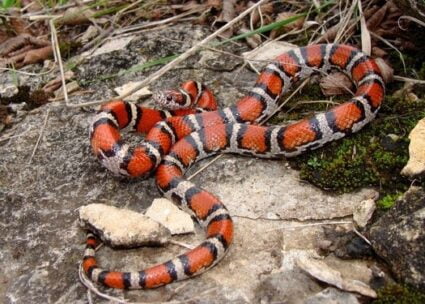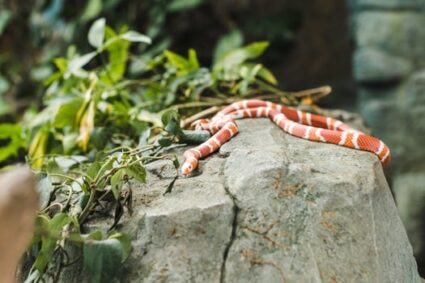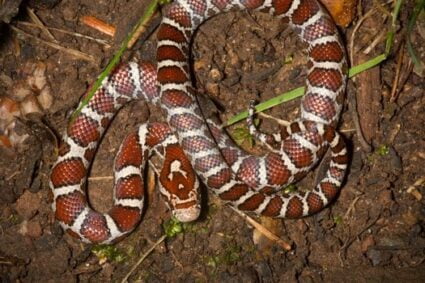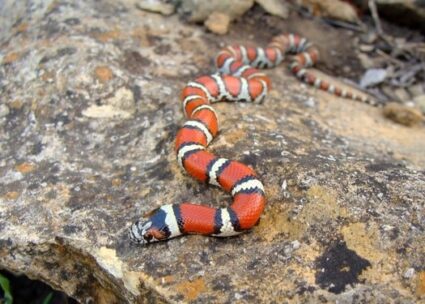Milk snakes, scientific name Lampropeltis triangulum, are part of a large family of Colubrid snakes, with more than 20 recognized subspecies. Each has bright, colorful scales that are banded like a coral snake. But unlike coral snakes, milk snakes lack the ability to envenomate their prey.
Milk snakes are easy to handle, unlikely to bite, and simple to care for. However, they can be anxious and may musk in self-defense. Milk snakes require a hot environment, so a wooden vivarium is a good choice. You should feed your milk snake thawed-frozen rodents and provide it with a water bowl big enough for the snake to get into.
Milk snakes come in a wide variety of colors and patterns. The American Naturalist looked at milk snake color types, including yellow bands, red dorsal spots or saddles, black rings, and collar-like bands around the neck. A milk snake may have any combination of these patterns.
Do Milk Snakes Make Good Pets?
Milk snakes are great pet snakes, especially for novices. They have an easy, gentle manner, and the steps for taking care of milk snakes are relatively simple. Snake owners have been successfully keeping and breeding milk snakes in captivity since the 1970s.
Milk snakes are also known for having ‘attitude’ and personality. They have quicker movement patterns than other, more lethargic pet snakes. This makes them fun to watch as they move around their vivarium.
What Kind Of Enclosure for Milk Snakes?
When providing a home for your pet milk snake, there are several qualities of the enclosure to consider. Let’s go over these details.
1/ Size and Material
Milk snakes require a warm temperature, so a material with good insulation is essential. Additionally, a great vivarium for a milk snake will also have a good level of ventilation, to allow the air to flow freely in and out, keeping humidity levels low.
Wood is an excellent heat insulator, making it easier to control and maintain the temperature inside. A wooden vivarium at least 34 inches long is ideal for your milk snake. This length makes it a comfortable amount of space for a nearly 4-foot-long snake. If the vivarium is measured in gallons, look for an enclosure which is at least 40 gallons in size.
There’s really no such thing as too big a home for an adult milk snake. Especially if it is a larger individual, a milk snake loves to have plenty of room to move around. The length of the vivarium also allows for the creation of separate warm and cool ends of the vivarium.
A baby milk snake does not need as large of an enclosure as an adult. Hatchling and juvenile milk snakes can live comfortably in a 10-gallon enclosure. Just be sure to increase the size as the snake grows.
Milk snakes are curious creatures who love to try to escape their enclosures. Make sure that your snake’s vivarium has a secure screen top and no cracks to escape through. Clamps are an excellent tool for holding a screen top in place.
2/ Substrate
Once you have chosen your vivarium for your snake, you need to put in the bedding. Snakes require a substrate to move around on, on top of the floor of their enclosure. Coarse beech woodchips are a substrate milk snakes do nicely on, and it is easy to clean.
Other examples of substrates commonly used are Aspen bedding, Repti bark, or cypress shavings. Paper products such as paper towels are also a good substrate option, especially for baby milk snakes.

Whatever substrate you choose, make sure it isn’t damp. An overly moist substrate can raise the humidity level in the vivarium too much, which is not healthy or comfortable for your milk snake. Be wary as well of substrate brands that contain high amounts of dust or oils. These extra substances can irritate a snake’s skin or lungs.
Remember to clean out the vivarium regularly. This means that, in addition to spot-cleaning any messes or excrement when you find them, you should take out and replace all of the substrate at least once a month. If you are using paper towels, then you will need to change them out much more frequently.
When you replace the substrate, take a moment to scrub out the inside of the vivarium to prevent the buildup of bacteria. Be sure that the tank is completely dry again before you return your milk snake to its home.
3/ Furnishings
Milk snakes do not usually live in trees in the wild. However, they do enjoy being able to climb on top of things and look around at their surroundings. You can give your snake things to climb on, such as pieces of wood or climbing branches, throughout its vivarium.
It is also a good idea to provide your milk snake with two hiding spots, one at the warm end of the enclosure and another at the cool end. Snakes are shy creatures who feel most comfortable when they have a place to hide away from sight, like a little cave or burrow.
For your milk snake’s vivarium, either a store-bought hide or a hide you make yourself from an old box or plastic container will work nicely. If you choose to make the hides yourself, make sure that they are sturdy. You don’t want the hiding place to collapse on and hurt your snake.
You might also consider decorating your milk snake’s vivarium with artificial plants for a more natural landscape appearance.
4/ Warmth and Light
To give your milk snake options based on how it’s feeling, make sure that the vivarium has a warmer side and a cooler side. The warmer side should be at 90 degrees Fahrenheit, while the cooler end should be between 75 and 80 degrees Fahrenheit.
A good way to create a warm spot in the vivarium is with a spot bulb. A single 40-watt basking light works well in a 3-foot-long enclosure. Ceramic heat emitters are also useful heat sources.
While milk snakes need warmth and light during the day, at night these snakes greatly prefer darkness. Turn off the basking light at night and maintain a nighttime temperature of around 80 degrees Fahrenheit. This temperature can be easily maintained with a heat mat underneath or on the side of the tank. Heat mats radiate heat without producing any light to bother your snake during the night.

Two tools that can help you maintain the vivarium’s temperature are a thermostat and a thermometer. The thermostat controls the heat mat, automatically turning the mat on when the vivarium temperature drops to or below 80 degrees. The thermometer is an indicator for you, allowing you to make sure the heating mat and basking light are doing their jobs right.
It’s a good idea to have two thermometers attached to your milk snake’s vivarium, one at the warm end and one at the cool end of the enclosure.
5/ Humidity
Most of the time, milk snakes do not like an overly humid environment – 40% to 60% will suffice. The one exception is during shedding. Like other reptiles, your milk snake will shed its entire skin all at once. Baby milk snakes shed their skin more often than adults do, since they are growing more quickly.
If your snake’s eyes turn a cloudy blue color, and its skin seems cloudy as well, you will know that it is shedding time. Use a mister to raise the humidity of the tank. You can also increase the humidity by providing the snake with a larger than usual water bowl.
The increased humidity will help the snake be able to peel free from its old skin. After the shedding period, allow the humidity level to go down again.
6/ Water Source
On the cooler end of your milk snake’s enclosure, provide it with a water bowl. This bowl should be large enough for the snake to get its body into. However, you should be sure that the bowl is not so big that the snake may have a difficult time getting into or out of it.
The water bowl has several purposes. It gives your milk snake a source of drinking water, and it helps raise the humidity for shedding. Make sure that the snake has a clean source of water. Change the water out once each day, and fully sterilize and clean the water bowl at least once each week.
What Should You Feed Your Milk Snake?
Researchers at Brigham Young University identify milk snakes as generalist predators. They found that these snakes feed on a wide variety of prey, including lizards such as skinks, small mammals, and also eggs from both reptiles and birds.
What milk snakes eat in the wild depends on how big the snake is and what is available. A smaller, younger snake is more likely to eat lizards, while an older, larger snake is more likely to eat mice and rats.
Milk snakes are carnivores and, in captivity, they thrive on frozen-thawed prey. Hatchlings should be fed a defrosted pinky mouse every week. As the snake grows, the size of the meal you offer should grow as well.
Adult milk snakes also do not need to be fed as often. Once every 2 weeks is a healthy frequency for feeding an adult milk snake. Choose a prey animal that is about the same size as the thickest part of your milk snake’s body. After your milk snake eats, there should be a noticeable lump.
Should You Feed Your Milk Snake Live Prey?
Sometimes milk snakes are picky eaters, turning up their noses at frozen prey. After all, there are no frozen rodents in the wild, just live ones. However, you should strongly consider feeding your milk snake thawed frozen rodents instead of living ones.
It is easier to get your hands on frozen rodents. Suppliers sell frozen rodents in bulk, and they are much cheaper than live mice or rats. It is much safer to give your milk snake a frozen rodent than a live one. A live mouse or rat will try to bite your snake to defend itself. In the wild, snakes can get away from difficult prey. In the vivarium, they have no means of escape, and rodent bites can lead to harmful infections.
If your snake is refusing a thawed frozen rodent, use a pair of tongs to wiggle the rodent around the vivarium. The movement of the prey can stimulate the milk snake’s feeding response.
Does Your Milk Snake Need a Companion?
Milk snakes are asocial animals. They can attack each other and express cannibalistic tendencies. This means that unless you are trying to breed milk snakes, you should never keep more than one milk snake in the same enclosure. A smaller snake might get eaten by its roommate.
Milk snakes do come together to breed in specific mating rituals. The Southwestern Association of Naturalists identified 3 distinct courtship sequences, including tactile-chase, tactile-alignment, and coital behaviors.
All you need to do to start breeding milk snakes is to keep a male and female snake together in the same tank. They need no extra encouragement besides being healthy and in a comfortable environment. Keep in mind that you will need to decide what to do with the babies.
How to Handle Your Milk Snake
Milk snakes are usually very easy to handle, especially compared to other more aggressive snakes. These snakes are not known to bite unprovoked. However, you should still give your snake a chance to get comfortable in its new home before you start to try to play with it.
Set up your milk snake’s vivarium in a room where humans frequently come and go, so that your snake can get used to the smells and sounds of humans. Give it a few days where your only interaction with the snake is feeding it, so that it comes to learn that you are a trusted source of food.
After your snake has had a chance to get used to its new home, be sure to handle it on a regular basis. This will help the milk snake get used to interacting with humans. Keep its body supported with both of your hands and allow it to freely explore your hands and arms.
In general, when you feed your snake, wait a couple of days to handle it. You need to give your snake the chance to digest its prey. Playing with the snake too soon after a meal can cause it to regurgitate its food.

How to Avoid Getting Bitten
If the snake is new and nervous around humans, it may decide to bite. Here are some steps to follow to avoid getting bitten by your milk snake.
- Give your snake the chance to get used to its new surroundings before you try to handle it.
- Use gloves the first few times you handle your snake in case it takes a nip at you.
- Snakes sometimes bite if they associate the appearance of a hand with the arrival of food. When feeding your milk snake, use tongs to present the food, so that the snake will not assume that your bare hand means it’s dinnertime.
- Do not touch the top of your milk snake’s head. Most snakes are “head shy” and perceive a touch on the head as a threat.
What If Your Milk Snake Gets Sick?
Milk snakes usually live around 10-15 years in captivity. This means that with proper care, they can live a long life with you. Be sure to watch out for common signs of illness in snakes:
- Frequent regurgitation
- Unusual amounts of lethargy
- Refusing to eat for long periods of time
- Difficulty breathing
- Spots, lumps, or bumps on the skin
- Difficulty shedding or unusually frequent shedding
Milk snakes are usually energetic and friendly animals, especially when they are young. If something seems off about your snake’s behavior, take it to a reptile veterinarian right away.
Due to their popularity as pets, milk snakes are commonly available at pet stores, reptile shows, and from private breeders. Check out your local Petco or Petsmart to start your search.

